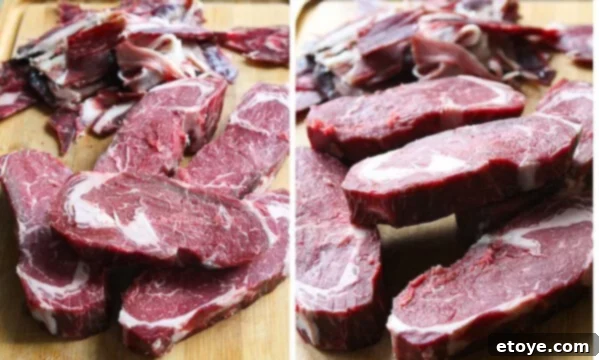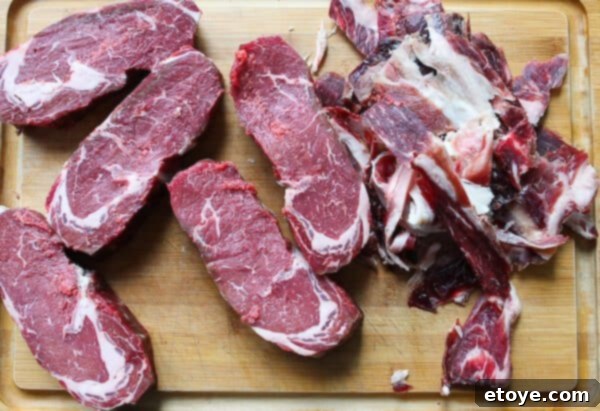
Mastering Dry Aging Steaks at Home: Achieve Restaurant Quality with UMAi Dry
Have you ever savored a dry-aged steak at a high-end restaurant and wished you could replicate that sublime experience at home? The good news is, you can! Dry aging beef, once a technique reserved for professional butchers and chefs, is now remarkably accessible to home cooks thanks to innovative products like the UMAi Dry Aged Artisan Steak Kit. This comprehensive guide will demystify the entire process, providing you with step-by-step instructions, expert insights, and invaluable tips to transform ordinary beef into an extraordinary culinary delight in your own refrigerator.
Dry aging is a time-honored tradition that enhances both the flavor and tenderness of beef. By carefully controlling moisture loss and allowing natural enzymes to break down muscle fibers, the process concentrates the meat’s savory notes, creating a rich, earthy, and complex profile that simply cannot be achieved with fresh beef. Prepare to impress your family and friends with steaks that rival the most expensive cuts from top steakhouses.
What you’ll discover in this ultimate guide to home dry aging:
- A detailed, easy-to-follow method for dry aging steaks at home, guaranteeing results comparable to premium restaurant offerings.
- How to effectively use specialized vacuum bags designed specifically for beef aging, compatible with most standard household vacuum sealers.
- An honest and in-depth review of the UMAi Dry Aged Artisan Steak Kit, drawing from over six years of personal experience and rigorous testing.
- A visual journey with high-quality photographs, illustrating the significant transformation of beef as it ages.
- Crucial safety guidelines, troubleshooting advice, and common pitfalls to avoid for a successful and delicious dry-aging experience every time.
This guide has been extensively updated on May 14, 2015, incorporating years of accumulated experience, product evolution, and community feedback.
Our deep dive into home dry aging began more than six and a half years ago, back in 2009. At that time, I reached out to Thea, the founder of what was then known as Drybag Steaks, to learn more about their pioneering product. Early versions of their bags required a specialized chamber vacuum sealer, an expensive piece of equipment that limited accessibility. However, through continuous innovation and a commitment to home cooks, UMAi Dry has ingeniously redesigned their bags to be compatible with a wide array of common vacuum sealers, such as the popular FoodSaver. This pivotal improvement has truly democratized home dry aging, opening up a world of gourmet possibilities. After thoroughly testing their starter kit over multiple aging cycles, I am eager to share my honest assessment and the proven techniques I’ve refined over the years.
The Magic of UMAi Dry Bags: A Scientific Approach to Home Dry Aging
The core of the UMAi Dry system lies in its revolutionary bags, which are fundamentally different from standard vacuum sealer bags. These aren’t just plastic pouches; they are engineered with a unique, semi-permeable membrane. This advanced material performs a crucial dual function during the dry aging process: it meticulously allows moisture to escape from the beef while simultaneously preventing oxygen from entering the bag. This creates an ideal, controlled micro-environment for dry aging.
As moisture slowly evaporates from the meat, its natural flavors become concentrated, leading to that intense, beefy taste prized by connoisseurs. Concurrently, the meat’s natural enzymes are activated, gently breaking down tough connective tissues, which results in remarkably tender steaks. The critical barrier against oxygen ensures that the aging process is safe and controlled, preventing spoilage and the development of undesirable molds. This ingenious technology is what allows you to achieve authentic dry-aged results right in your home refrigerator.
My personal journey with UMAi Dry bags spans over six and a half years, during which I’ve conducted countless aging trials. For the detailed insights presented in this article, I meticulously documented four distinct aging tests: two with a whole ribeye loin and two with a strip loin. Throughout these extensive experiments, I captured more than 300 photographs to illustrate every critical step and the visual progression of the aging beef. The images shared below are a carefully curated selection from these comprehensive tests, providing the clearest visual narrative of the dry aging process. Should you notice slight variations in the appearance of the steaks between photos, rest assured it’s simply due to differences in the test batches and the specific cuts of meat used.
A Paramount Safety Warning for Home Dry Aging: Success in dry aging hinges on one non-negotiable factor: consistent temperature control. You absolutely must maintain a steady refrigeration temperature between 34°F and 38°F (1°C and 3°C). Any significant fluctuation outside this range can compromise safety and ruin your expensive cut of beef. Therefore, an old, unreliable, or frequently accessed refrigerator (e.g., one that children constantly open and close) is entirely unsuitable for this delicate process. If you cannot guarantee a stable, dedicated cold environment, it is highly recommended to either invest in a more reliable appliance or entrust the dry aging to a professional. Precision is key to a safe and delicious outcome.
Let’s begin our practical journey by introducing the star of the show: a magnificent whole beef loin.

Selecting the Ideal Vacuum Sealer for UMAi Dry Bags
One of UMAi Dry’s significant advancements is the compatibility of their bags with most external vacuum sealers available today. While older dry aging methods sometimes required specialized chamber vacuum sealers (like the one shown below, which was common before the advent of popular brands like FoodSaver), current UMAi Dry bags are much more versatile. Flat-style vacuum sealers are often the easiest to use, primarily because many allow for manual control over the vacuuming and sealing functions. This manual override is crucial for UMAi Dry bags, as it enables you to achieve a perfect, snug seal without over-vacuuming the delicate membrane. Newer, taller vacuum sealer models can sometimes make this manual control a bit more challenging, but it remains achievable with UMAi’s redesigned bags. To see how to get a great seal, watch this helpful video demonstrating sealing with a FoodSaver.

Pictured here is my trusty, older-style vacuum sealer, which still performs admirably with UMAi Dry bags.
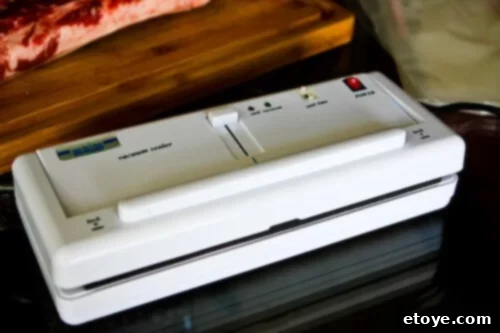
Preparing Your Beef Loin: Critical First Steps for Optimal Adhesion
Before bagging, you’ll need to prepare your beef loin. Whole primal cuts are often too large to fit into a single UMAi Dry bag, so the first step is usually to carefully cut the loin into more manageable sections, typically halves. Ensure your cuts are clean and even for best results during aging.
A Crucial Tip: Avoid This Common Preparation Mistake! This insight comes from extensive hands-on experience and is vital for successful dry aging: When you first unwrap your beef loin from its cryovac packaging (as is common when purchasing from bulk retailers like Costco or Sam’s Club), do NOT trim off any of the outer fat, and, perhaps counter-intuitively, do NOT wipe away the “gooey, bloody mess” coating the meat. This isn’t just about presentation; it’s fundamental for the UMAi Dry bag to work its magic. Thea from UMAi Dry emphasizes this point:
“To create the best (and, ultimately, safest) bond between the surface of the meat and the DrybagSteak material, it is critical that the meat be well coated with proteins–i.e., bloody and gooey like right when you crack it out of the cryovac if you purchase meat from Costco or Sam’s Club.” ~ Thea, UMAi Dry
This protein-rich, somewhat sticky surface is essential for the UMAi Dry bag’s membrane to adhere properly and form a tight, continuous seal with the meat. Neglecting this step can lead to air pockets and an uneven, potentially compromised aging process, so resist the urge to clean the meat thoroughly at this stage.
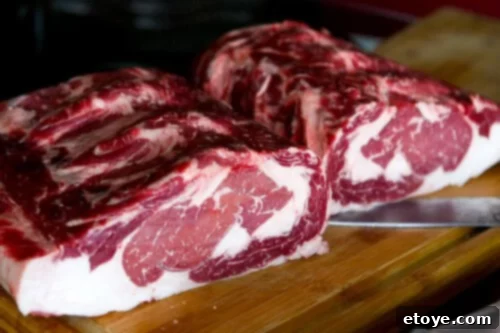
The UMAi Dry Bagging and Precision Sealing Process
With your beef loin correctly prepared, it’s time to place it into the UMAi Dry bag. Carefully slide the loin into the bag, ensuring it fits snugly but without excessive stretching. While you can trim some excess bag material, make sure to leave a generous amount—at least several inches—beyond the end of the meat. This extra length is invaluable for inserting the bag into your vacuum sealer and, more importantly, provides crucial leeway for re-sealing if your initial attempt isn’t perfect. This foresight can save you from wasting a bag and starting over.
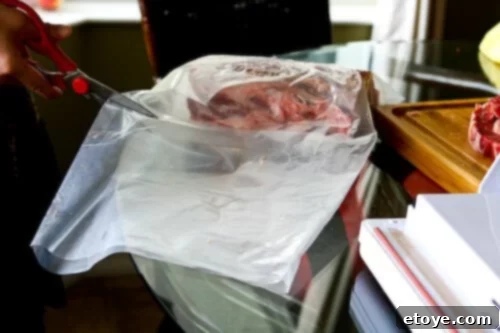
Now, proceed to meticulously vacuum seal the bag. The objective here is to achieve a tight, secure seal that maximizes contact between the UMAi Dry bag and the entire surface of the meat. This intimate contact is what initiates the formation of the bag’s unique semi-permeable membrane. It’s critical to reiterate that only genuine UMAi Dry bags possess the specialized properties necessary for safe and effective dry aging. Do not attempt this process with standard vacuum sealer bags, such as those from FoodSaver, or any other brand. Regular bags are designed to completely block moisture and oxygen, which is precisely the opposite of what dry aging requires. Using incorrect bags will prevent moisture release, potentially lead to anaerobic spoilage, and result in an unsafe product. Always verify you are using authentic UMAi Dry bags for optimal, safe results.
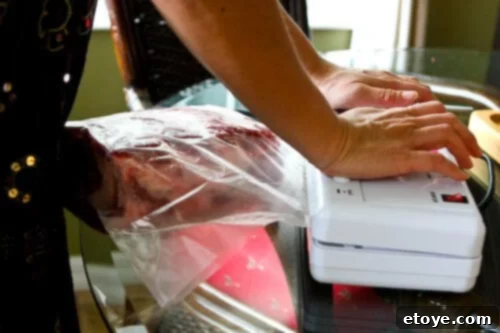
Ensure a consistently firm and even seal across the bag for the best outcome.
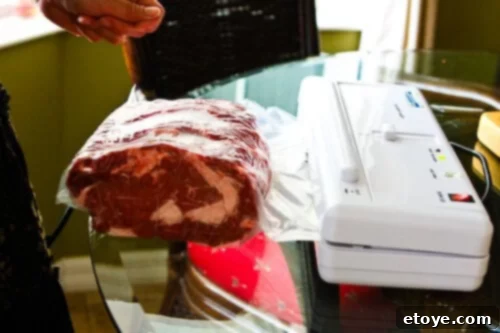
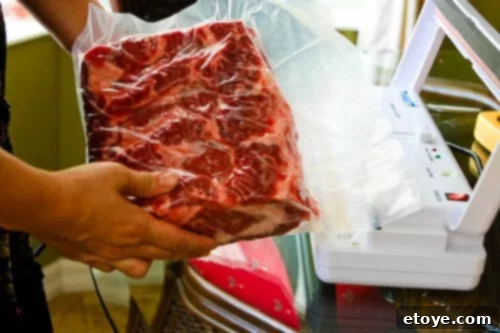
Establishing the Ideal Aging Environment: Refrigerator Placement and Constant Monitoring
Once your beef loin is securely sealed in its UMAi Dry bag, it requires a dedicated spot within your refrigerator. The placement is more critical than you might think: always position the bagged loin on a heavy wire rack. This isn’t just for structural support; it’s absolutely vital for ensuring optimal air circulation around all surfaces of the meat. Adequate airflow is essential for the UMAi Dry membrane to function correctly and for even moisture loss. Additionally, it is imperative to place a reliable refrigerator thermometer directly near the aging loin. This allows for continuous monitoring, ensuring the temperature remains strictly within the critical range of 34°F-38°F (1°C-3°C). Consistent temperature is the cornerstone of safe and successful dry aging.
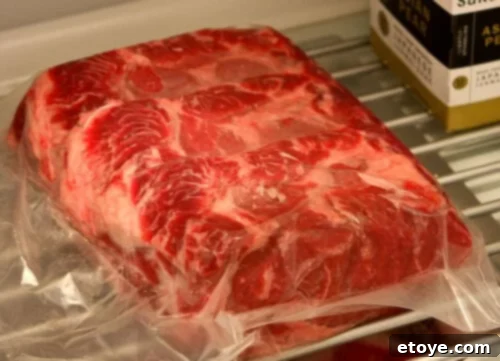
For an even more effective aging environment, particularly with larger cuts or if your refrigerator space is somewhat constrained, consider elevating the wire rack slightly. Using small, stable risers or blocks beneath the rack can significantly enhance airflow underneath the meat. This simple modification promotes more uniform drying and contributes to a superior dry-aged product.
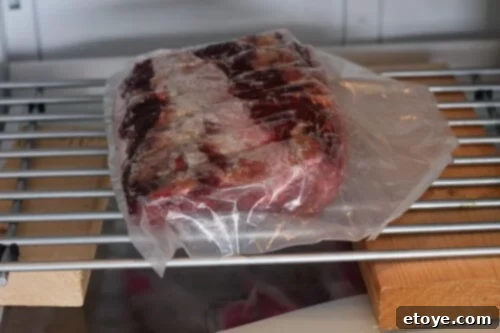
Troubleshooting: Identifying and Addressing Air Pockets During Aging
Despite careful initial sealing, it’s possible for air pockets to develop inside the UMAi Dry bag during the aging process. During one of my initial test runs, I observed noticeable trapped air pockets partway through the aging period. This is an undesirable situation, as trapped air can lead to inconsistent drying, potential bacterial growth, and a compromised final product. This specific issue arose because I had made the aforementioned mistake of trimming off the outer fat and wiping away the natural “bloody goo” from the loin before bagging. As UMAi Dry explains, this protein-rich surface is crucial for the bag’s membrane to achieve a secure, clingy bond with the meat. Without it, the membrane struggles to adhere properly, allowing air to become trapped. Should you notice any air pockets forming during the aging period, it is imperative to gently press out the air and carefully re-seal the bag, ensuring maximum contact between the bag and the meat. Having extra bag length, as advised earlier, will prove invaluable for such re-sealing attempts.
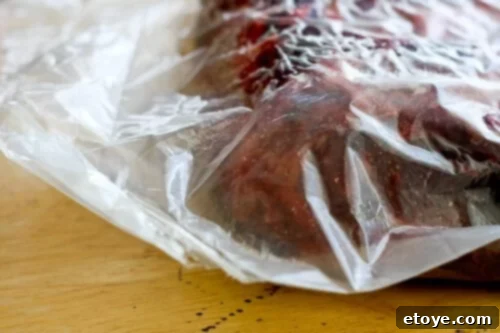
Ideally, your UMAi Dry bag should maintain a consistently tight, suctioned appearance throughout the entire aging period, like the example shown here:
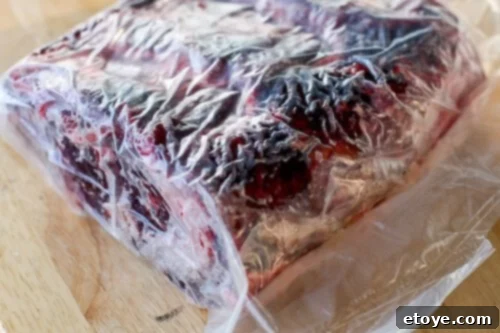
The Revelation: Post-Aging Preparation and Slicing Your Masterpiece
After your chosen aging duration—typically ranging from 7 to 21 days, with 14 days often considered a sweet spot for a balanced flavor and tenderness profile—your dry-aged loin is finally ready! Upon removal from the refrigerator, you’ll notice the UMAi Dry bag has become tightly adhered to the meat, truly acting as a second skin or membrane. It should peel away with relative ease, much like removing a wrapper, revealing the distinct dry-aged crust beneath.

The next critical step is to meticulously trim away the outer, tough, and often discolored layer known as the pellicle. This layer, while essential for protecting the interior meat and concentrating its flavors during aging, is too dry and tough for consumption. Using a very sharp knife, carefully and methodically remove this outer crust from all sides of the loin. Your goal is to expose the beautiful, deep red, tender meat beneath. This trimming process will inevitably result in some weight loss, but it is a necessary step to unlock the incredible flavor and tenderness of your expertly aged beef.
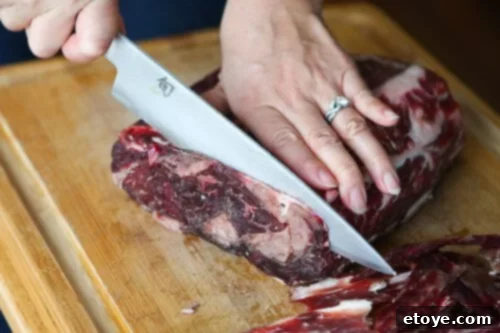
Continue trimming with precision around the entire loin, ensuring that all of the dry, hardened outer layer is removed to reveal the pristine aged meat underneath.
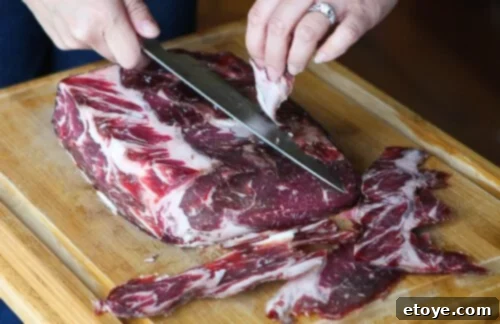
The satisfying result: a perfectly trimmed, exquisite loin, ready for slicing.

With the pellicle expertly removed, you can now slice your magnificent dry-aged loin into individual steaks of your preferred thickness. Take a moment to admire the rich, deep red color and the intricate marbling—these are the unmistakable characteristics of expertly aged beef. Each slice is a promise of an exceptional culinary experience, a testament to your patience and effort.

Behold: a truly spectacular dry-aged steak, primed for perfection on the grill or in the pan.
The Unmistakable Flavor and Tenderness of Dry-Aged Steak
The ultimate reward for your patience and effort is the taste—and it is, simply put, phenomenal. Dry aging concentrates the natural beef flavors, leading to an incredible depth and complexity that fresh steak simply cannot match. You’ll discover profound beefy, earthy, and even subtly nutty notes that hit every part of your palate, creating a multi-layered flavor profile. This enhanced umami experience is coupled with a noticeable improvement in tenderness, as the enzymes have diligently worked to break down the meat’s structure, resulting in a more succulent and enjoyable bite.

While dry aging significantly amplifies a steak’s inherent qualities, it’s important to remember that the final taste and texture are also influenced by several foundational factors: the initial quality and breed of cattle, their diet and rearing conditions, the exact duration of the aging process, and, of course, your cooking expertise. For those eager to deepen their understanding and appreciation of premium beef, delving into the nuances of artisan steak tasting can provide invaluable insights. However, even with a high-quality Choice grade steak, dry aging with UMAi Dry will confidently amplify its natural beefiness and complexity by a factor of ten, transforming it into a truly gourmet experience.
Frequently Asked Questions About Home Dry Aging with UMAi Dry
Many aspiring home dry agers have similar questions and concerns before embarking on this culinary adventure. Here are answers to some of the most common inquiries:
Q: Does home dry aging with UMAi Dry produce results comparable to professionally aged steaks?
A: In my extensive experience, the results achieved with UMAi Dry bags at home are remarkably similar to those of professionally aged steaks. The primary distinctions often lie in the initial grade of beef (e.g., Prime vs. Choice) and the precise aging duration. While high-end butchers and restaurants typically age premium Prime cuts, my tests with more accessible and affordable Choice steaks consistently yielded incredibly flavorful and tender results that rivaled many professional offerings. Considering the significant cost savings, I personally choose affordable home-aged steaks over their pricier butcher or restaurant counterparts any day. Critical to achieving these excellent results is strict adherence to UMAi Dry’s guidelines: ensuring correct sealing, maintaining consistent refrigeration temperatures, and providing adequate air circulation around the loin.
Q: How effective are UMAi Dry Aged Steak Bags compared to traditional home aging methods without them (e.g., cheesecloth)?
A: From a purely taste perspective, both UMAi Dry bags and traditional methods like cheesecloth can yield fantastic results. However, the difference in process is immense. Traditional dry aging with cheesecloth demands considerably more effort, constant vigilance, and is inherently messier. You find yourself frequently cleaning and replacing dirty, bloody, and crusty cheesecloth layers—a process that can be quite unappetizing and time-consuming. UMAi Dry bags completely eliminate this hassle. They save immense time and alleviate concerns about continuously exposing the meat to potential contaminants or refrigerator odors. While UMAi Dry bags represent an initial investment (a starter kit with a sealer and bags might cost around $130-$150, though individual bag refills are more affordable at about $25), the unparalleled convenience, cleanliness, and peace of mind they offer far outweigh the marginal cost difference compared to the cheap but cumbersome cheesecloth alternative. It’s an investment in both quality and convenience.
Q: Can I use my existing vacuum sealer and bags for the UMAi Dry aging process?
A: You can indeed use most standard external vacuum sealers with UMAi Dry bags. UMAi has thoughtfully updated their product design to include “VacMouse” bag inserts. These small, porous strips create a channel that facilitates the vacuuming process with a wider range of household vacuum machines. As noted earlier, some sealers offer more intuitive manual control over the vacuuming and sealing cycle, which can be advantageous for achieving the optimal seal with UMAi bags. However, it is absolutely crucial to understand that only genuine UMAi Dry bags are suitable for dry aging. Standard FoodSaver bags or other conventional vacuum bags are designed to create an airtight, moisture-impermeable seal for general food storage. This design prevents the controlled moisture loss essential for dry aging, making them ineffective and potentially unsafe for this specific process. Using them for dry aging would risk spoilage and produce an undesirable outcome. For a practical visual guide on how to achieve a proper seal with a common model, watch this video demonstrating sealing with a FoodSaver V3800.
Final Thoughts and Expert Recommendations for Your Home Dry Aging Journey
The continuous improvements to the UMAi Dry Aged Steak Kit, particularly the thoughtful inclusion of VacMouse bag inserts for broader vacuum sealer compatibility, represent a significant advancement. These enhancements have successfully addressed many of the initial challenges and have made the process considerably more user-friendly and accessible to the average home cook.
One critical piece of practical advice from years of experience: The bags can sometimes be a bit particular during the initial sealing process. I’ve occasionally found myself needing to attempt sealing two or three times to achieve that perfect, airtight vacuum. To mitigate frustration and avoid wasting bags, always ensure you leave a generous amount of excess bag material—at least several inches—beyond the meat. This extra length provides ample room to snip off an imperfect seal and re-seal the bag if necessary, without having to discard the entire bag and start over with a new one.
Similarly, it’s wise to periodically inspect your aging loin for any developing air pockets. As illustrated in the photos above, even after an initial successful seal, small air pockets can sometimes form. If you observe any, gently press out the trapped air and carefully re-seal the bag. Again, that extra bag length will prove invaluable here, allowing you to snip and re-seal without compromising the overall aging process. This minor extra step is a small price to pay for the significant ease, safety, and superior results that UMAi Dry offers compared to the traditional, exposed-meat cheesecloth method.
I personally find myself dry aging whole beef loins with UMAi Dry bags approximately 4-5 times a year. It’s important to remember that dry aging is typically performed on entire primal cuts, not individual steaks. A whole loin is a substantial piece of meat, making it ideal for special occasions, large family gatherings, or for stocking your freezer with gourmet steaks. For instance, I’m already planning to dry age a standing rib roast for our upcoming Christmas dinner—it promises to be a truly show-stopping centerpiece that will delight everyone at the table!
The initial investment of around $130-$150 for a starter kit (which usually includes the vacuum sealer, detailed instructions, and a supply of bags) is, in my opinion, absolutely worth it for the consistent results and unparalleled convenience. However, it’s worth noting that UMAi Dry’s core business revolves around selling their specialized bags, not the vacuum machines themselves. If you already own a compatible vacuum sealer, you can purchase refill bags for about $25, significantly reducing the cost per aging cycle and making this a very economical way to enjoy premium dry-aged beef.
The ideal target market for UMAi Dry is clearly small, artisanal restaurants or passionate home cooks who have a dedicated extra refrigerator or ample freezer space. Since you’re dealing with an entire loin, you’ll need significant room for both the aging process and the subsequent storage of the cut steaks (or the whole roast) in your freezer. If your primary kitchen refrigerator is already perpetually packed and frequently accessed by a busy family, I strongly advise against attempting home dry aging in it. The constant opening and closing of the door will lead to unstable temperatures, making the process unsafe and jeopardizing the quality of your expensive beef. A stable, consistently cool, and relatively undisturbed environment is absolutely paramount for success.
For my own dry aging projects, I exclusively utilize the refrigerator in my garage. This appliance is primarily used for storing beverages and occasional spirits, meaning it’s opened far less frequently than my main kitchen fridge. While I confess it gets opened “quite often” for those purposes, it nonetheless offers a much more stable temperature environment. I always keep a reliable refrigerator thermometer directly on the shelf with the aging loin, allowing me to maintain constant awareness and precise control of the temperature.
Once the loin has completed its dry aging, I typically slice it into thick, individual steaks—generally ranging from 1 1/4 to 1 1/2 inches thick. These perfectly aged steaks are then individually vacuum-sealed using my regular FoodSaver vacuum sealer and stored in the freezer, ready to be enjoyed at a moment’s notice. For larger cuts, such as the upcoming Christmas standing rib roast, I will leave it whole to be cooked as a magnificent centerpiece.
Optimal Aging Duration: Finding Your Sweet Spot
Regarding the optimal aging duration, I’ve personally experimented with various periods: 7 days, 14 days, and 21 days. My consistent “sweet spot” has been 14 days. While a 21-day age certainly delivered an even deeper, more intense flavor profile (it absolutely did!), my personal impatience often gets the better of me! However, for truly special occasions like Christmas dinner, I am more than prepared to commit to the full 21 days, knowing the exceptional reward it brings. My family, thankfully, wouldn’t appreciate a Christmas dinner rushed simply because I couldn’t wait another week to enjoy that magnificent roast!
The Science Unveiled: How UMAi Dry Bags Achieve Their Magic
The exact science behind how UMAi Dry bags manage to allow moisture out while simultaneously preventing oxygen from entering is indeed fascinating and was a point of curiosity for me initially. Thankfully, our engaged community of readers and further research have provided excellent insights:
UPDATE #1: Commenter Bruce offers a compelling explanation:
“I’m guessing that the bags work by having tiny holes of just the right size. Oxygen molecules (O2 – two oxygen atoms stuck together) are a bit bigger than water (one oxygen with two hydrogens, but hydrogen is really, really small).”
This explanation, while a simplification, points to the core principle of selective permeability based on molecular size, a sophisticated concept leveraged in advanced membrane technologies. The UMAi Dry bag effectively acts as a one-way valve for water vapor, allowing it to escape, while creating an impenetrable barrier for larger oxygen molecules, thus preventing aerobic spoilage. Further information provided by the owner of UMAi Dry confirms the sophisticated nature of these bags. They are indeed highly permeable to water vapor, facilitating the controlled dehydration essential for dry aging, while rigorously maintaining an oxygen barrier to prevent contamination. This technology is backed by scientific testing, with studies focusing on the “Effects of dry aging of bone-in and boneless strip loins using two aging processes for two aging times,” underscoring the product’s effectiveness and safety.
Beyond Dry Aging: Other Ways to Enhance Steak Flavor and Tenderness
If the commitment or setup for dry aging doesn’t quite appeal to you at this moment, there are other fantastic and simpler ways to significantly improve your steak. Consider exploring the technique of salting steaks. It’s a simple yet powerful method for tenderizing and enhancing the flavor of almost any cut, a true game-changer for your everyday steak cooking!
Support Our Culinary Explorations!
If this detailed guide has inspired you to embark on your own dry aging journey or deepened your understanding of this incredible culinary technique, please consider supporting our site through the affiliate links below. Your support helps us continue to provide valuable culinary content, in-depth reviews, and exciting new recipes.
